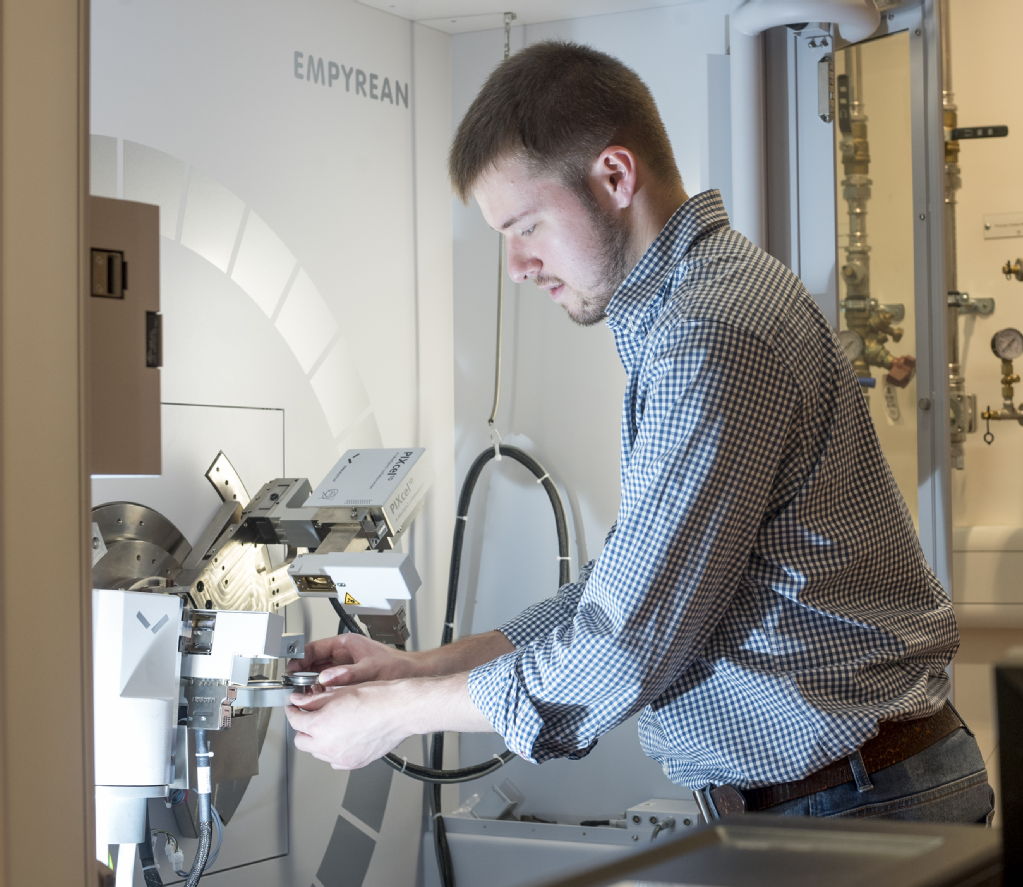X-Ray Diffraction (XRD)
X-ray Diffraction (XRD) is a powerful non-destructive technique for characterizing crystalline materials. At Warwick we have single crystal, powder and high-resolution diffraction capabilities. We will also have Small Angle X-ray Scattering (SAXS).
Applications:
Typical measurements include phase identification, structural determination, Rietveld refinement; determination of phase contamination and sample purity; layer thickness, composition and roughness; stress and texture measurements.
Typical samples include powders, polycrystalline materials, semiconductors, coatings, thin films, metals, nanomaterials, clays, glass and contaminated products.
 How does it work?
How does it work?
X-ray diffraction in the laboratory uses photons produced from a metal target to diffract off a crystal lattice plane with a spacing similar to the wavelength of the X-rays (~ 10-10 m). Information on the crystal structure, crystalline phases, preferred crystal orientations (texture), and other structural parameters, such as average grain size, crystallinity, stress, strain and composition can all be obtained using X-ray diffraction.
Powder diffraction relies on the diffraction from randomly orientated grains to produce a semi-unique 1D pattern, which at its simplest can be matched against a database of known structures. More advanced studies can refine a structural model (Rietveld refinement) to obtain information on the crystal structure at the atomic level.
Single crystal diffraction is a powerful X-ray technique for the solution of small-molecule crystal structures. It provides key information on the symmetry and atomic positions. Usage spans from routine structural work on organic and metal-organic small molecules to highly detailed investigations of heavy metal oxides that can include twins, modulated structures and/or diffuse scattering.
High-resolution X-ray diffraction uses highly monochromatic X-rays to study individual Bragg peaks of bulk single-crystal and thin-film materials. Typical routine applications of high-resolution XRD include reflectivity measurments, rocking curves and reciprocal space mapping. This allows for the precise measurement of layer thicknesses, layer composition analysis and diffuse scatter measurements to be performed. In addition, the diffractometers can be reequipped to allow stress and texture measurements to be undertaken.
Warwick Capability:
The powder diffraction facility at Warwick is extremely well equipped for the study of a wide variety of powders, polycrystalline samples and ceramics. We have five diffractometers covering high-throughput, high-resolution, high-temperature (up to 1200 °C), low-temperature (down to 12 K) and in-situ reactions. This allows for both simple Phase-ID and more complicated and detailed studies to be undertaken. A higher energy Mo wavelength diffractometer is available for avoiding fluorescence and transmission measurments.
The X-ray facility at Warwick is equipped with two state-of-the art dual wavelength (Mo/Cu) microfocus single-crystal diffractometers. The Rigaku Oxford Diffraction Synergy S with a HyPix-6000SE hybrid photon counting detector and a SuperNova equipped with an Oxford Cryosystems N-Helix cryo cooling system allowing for data collection down to 25 K. We additionally have the capability to undertake high-pressure measurements on these instruments.
The high resolution X-ray facility consists of two Panalytical X'Pert Pro MRDs. In their standard configuration, the X'Pert Pro MRDs are both equipped with a Cu Kα1 hybrid monochromator as the incident beam optics and a receiving slit / analyser crystal in the diffracted beam optics. For the highest resolution measurements, a mirror & monochromator combination can be used, whilst for reflectivity a parallel plate collimator is available on the diffracted beam optics. A high temperature stage (up to 1100 °C) is also available.
For further information on the XRD Capability at University of Warwick, please see the dedicated X-Ray information pages.
Complementary Techniques:
SAXS, SEM, TEM, EDX, EBSD, NMR, Optical Microscopy, SIMS, Raman Spectroscopy, XRF, XPS
Contact:
Claire Gerard: c dot gerard at warwick dot ac dot uk / 07385 145064
Contact:
Dr Ian Hancox, 024 76 150 380
email i dot hancox at warwick dot ac dot uk.
Status |
Availability |
 |
Warwick collect/analyse data |
 |
Warwick collect data |
 |
Available to user with expertise/ contribution |
 |
Spare capacity for collaborative research |
BOOK NOW |

